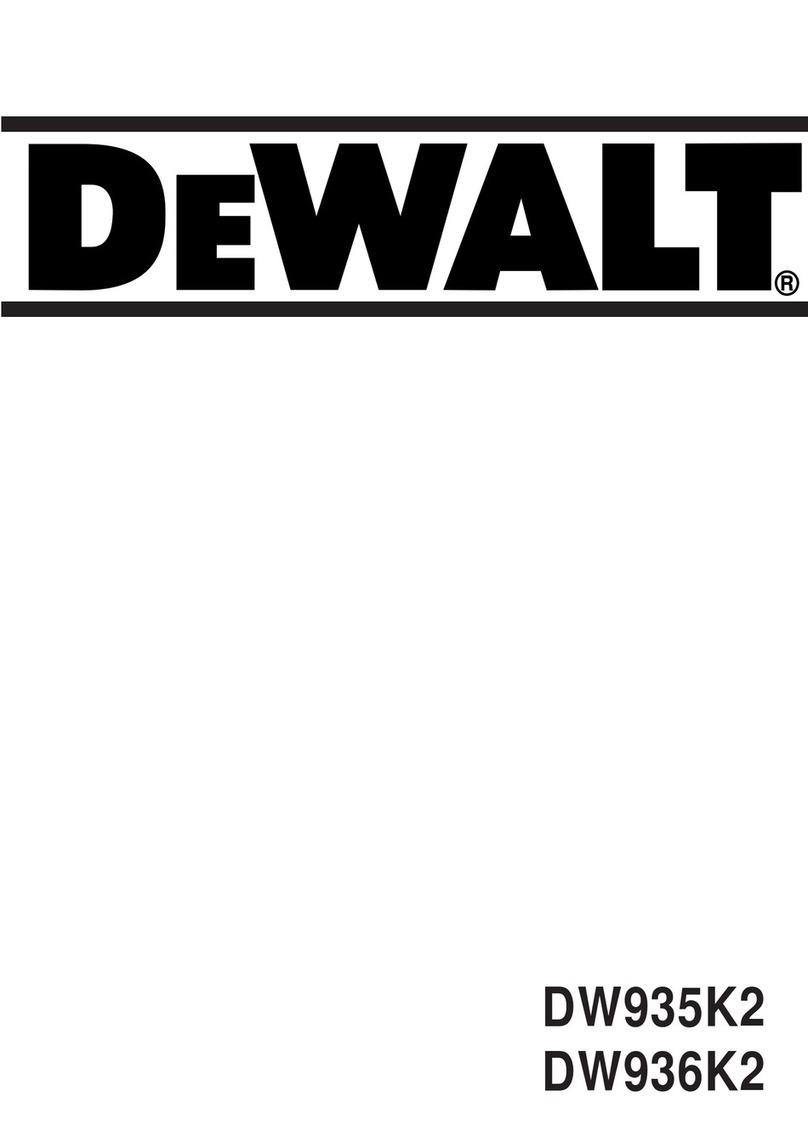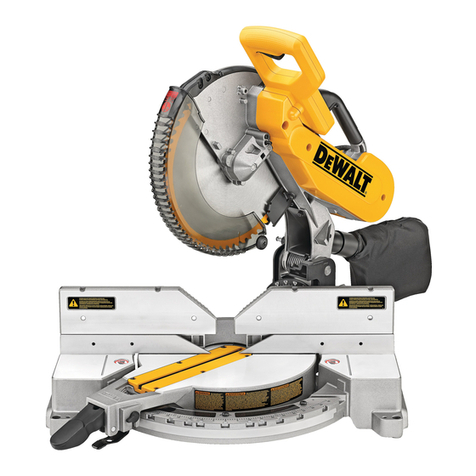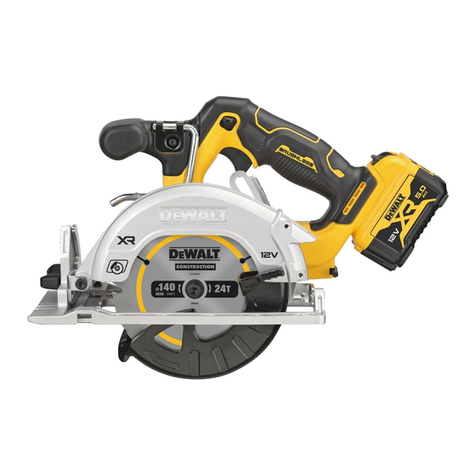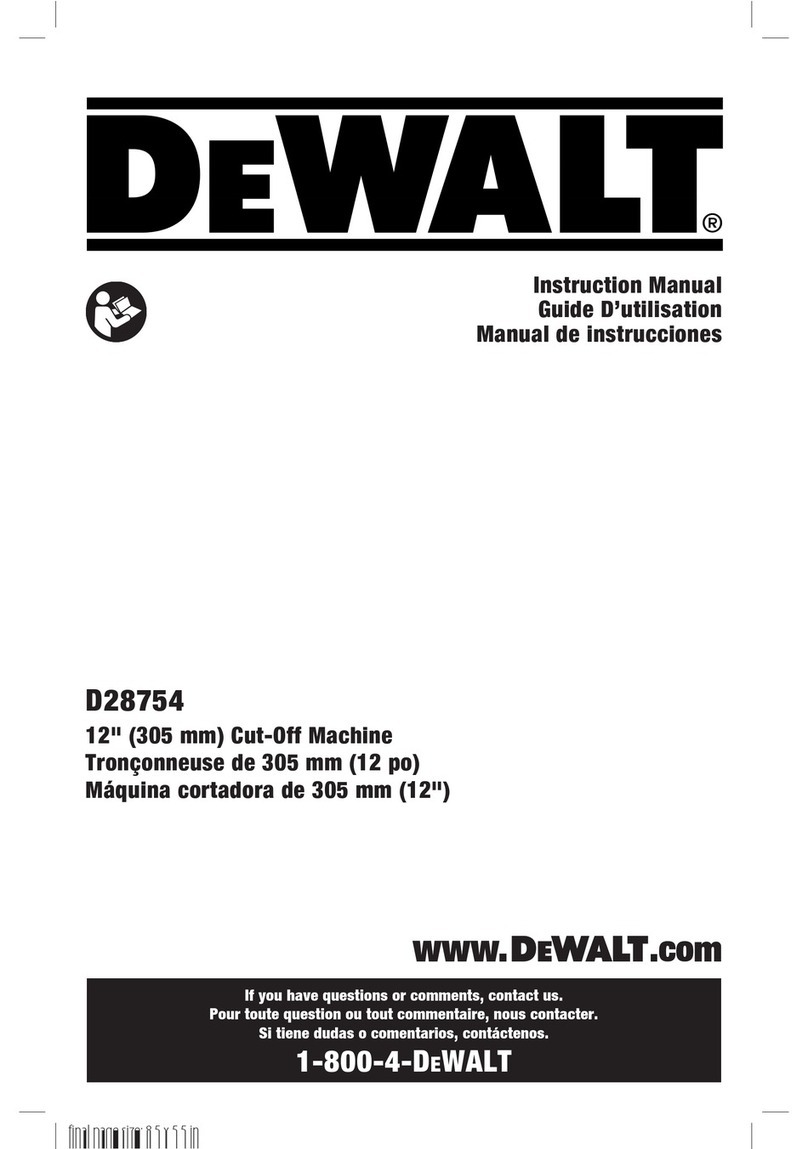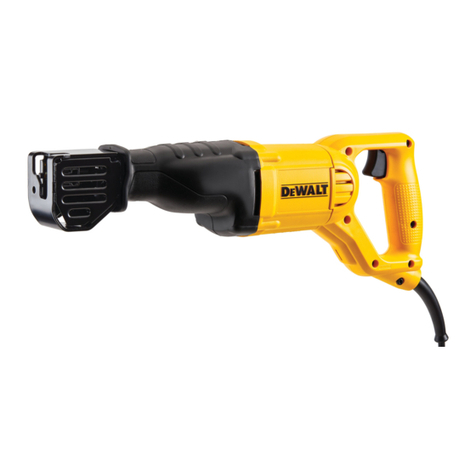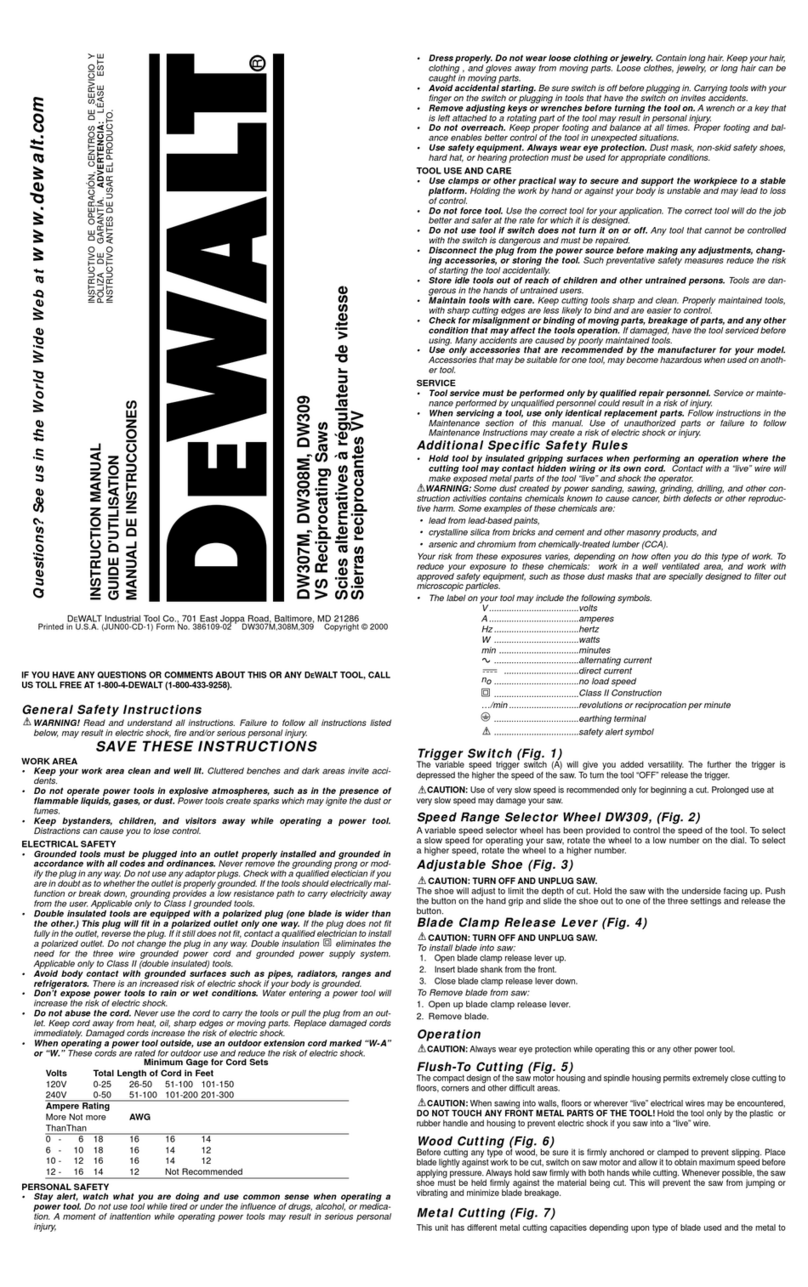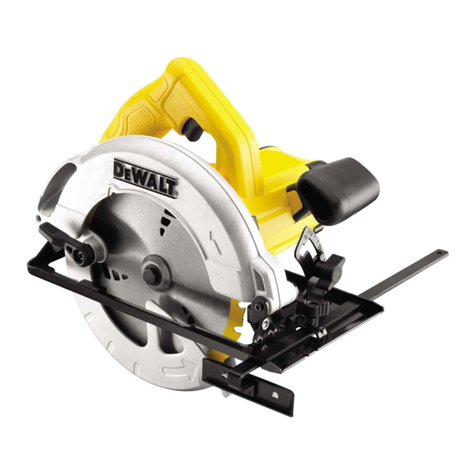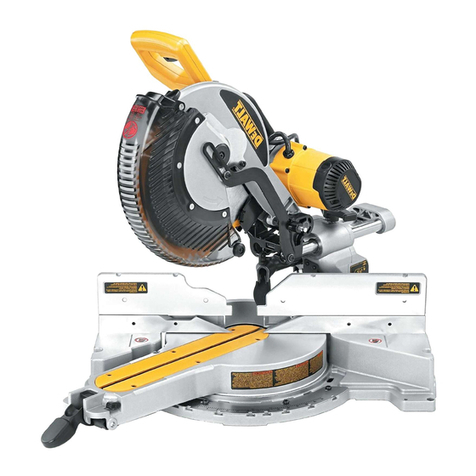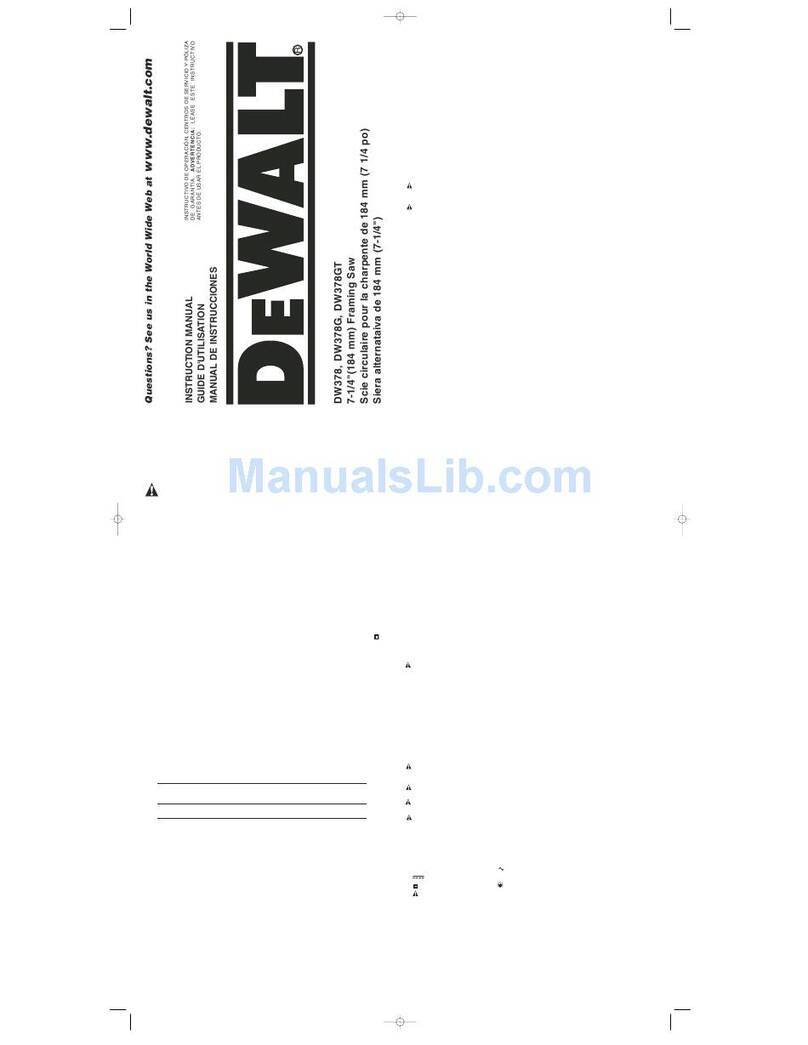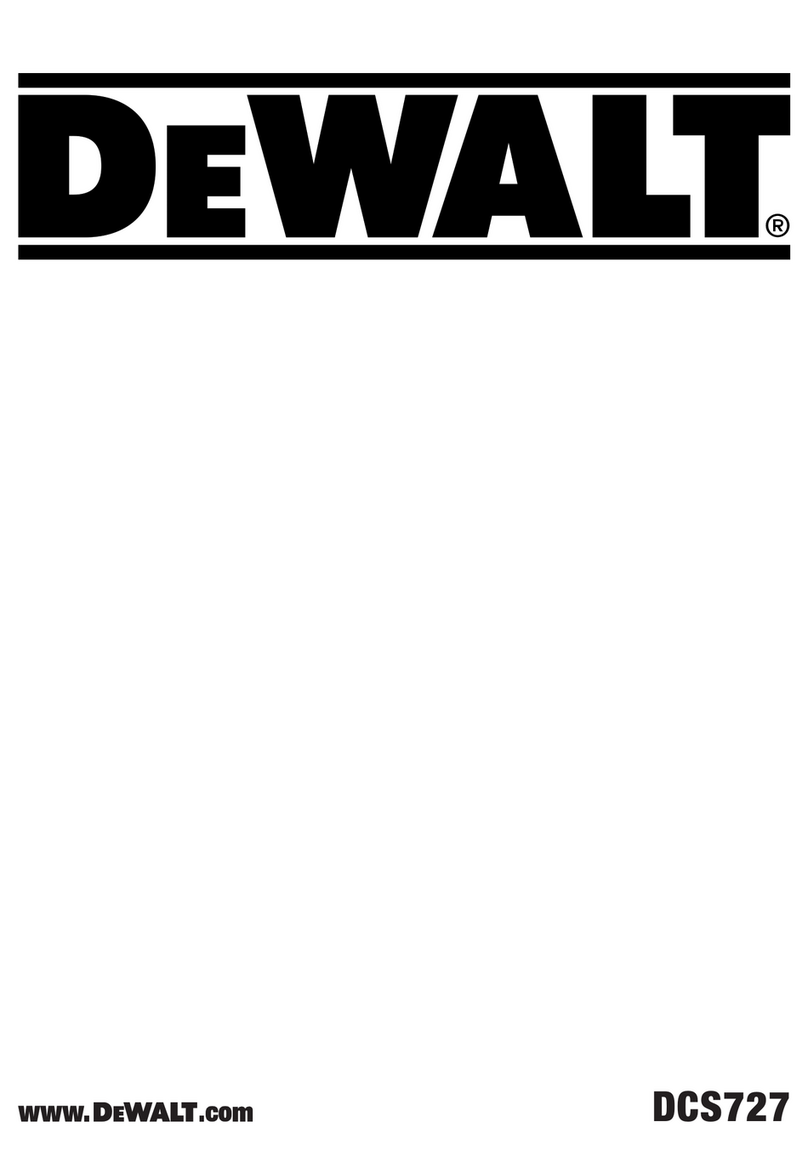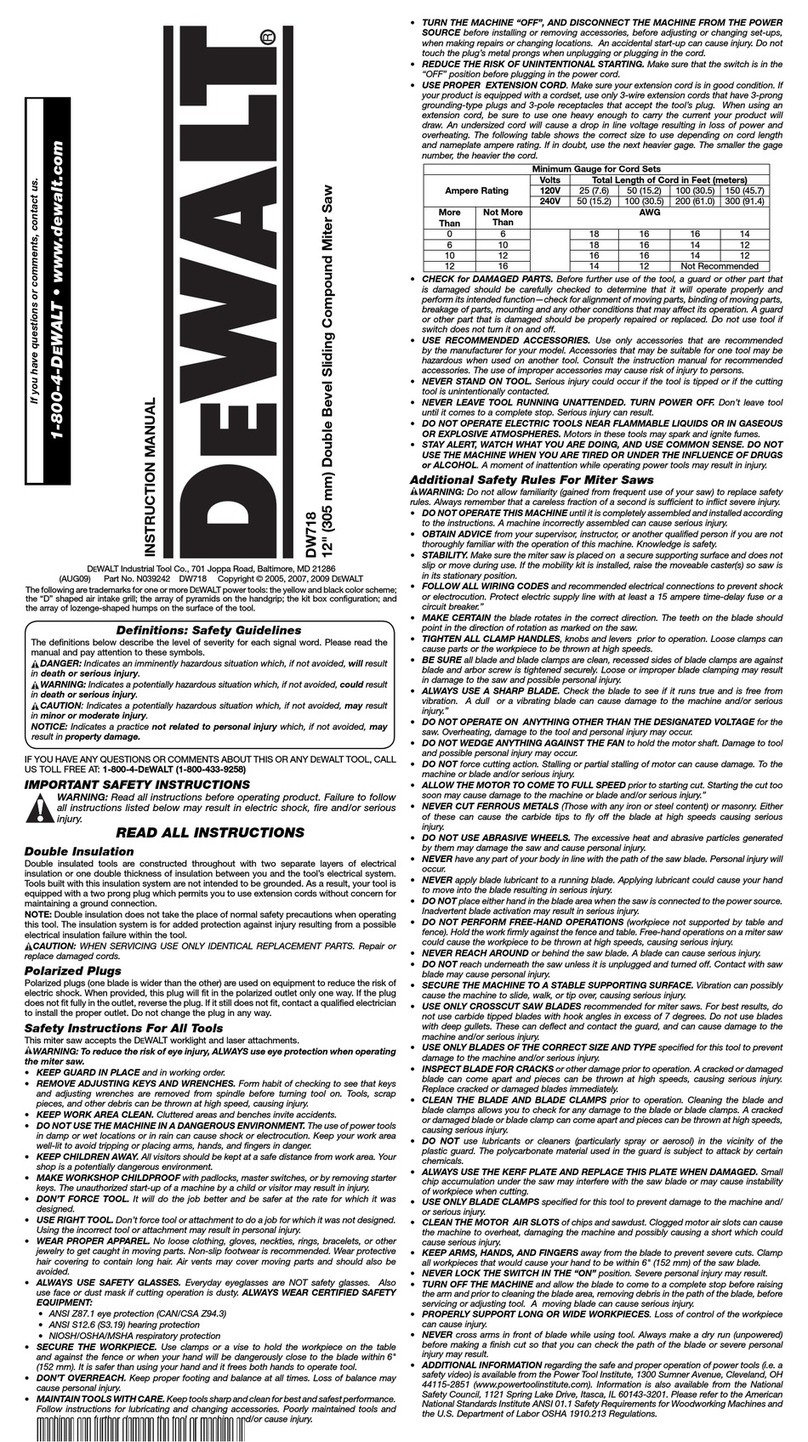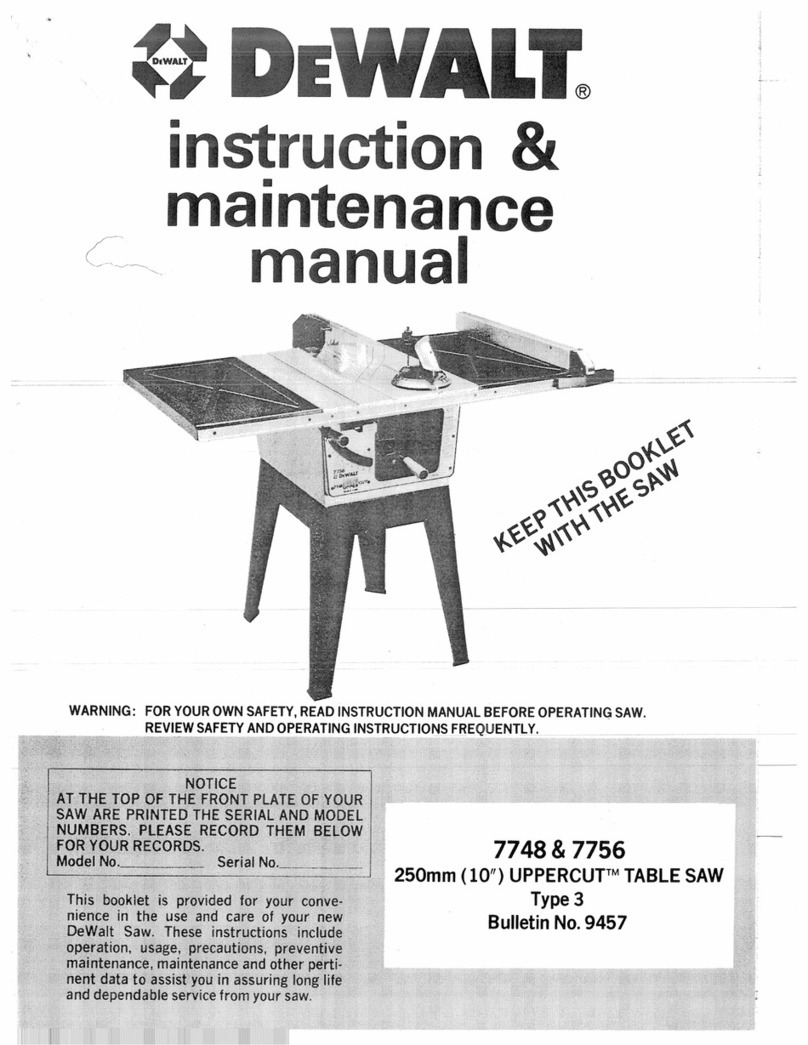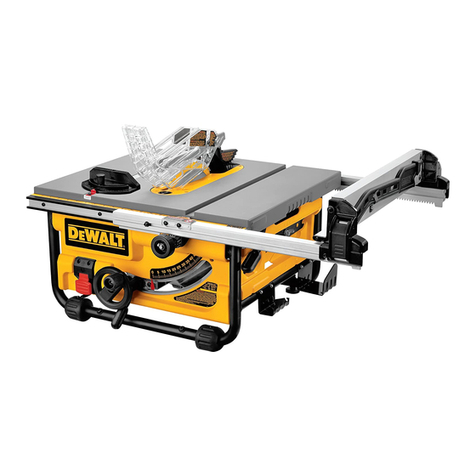
7
ENGLISH
etc. Abrasive dust causes moving parts such as the lower guard to jam. Sparks from
abrasive cutting will burn the lower guard, the kerf insert and other plasticparts.
b ) Use clamps to support the workpiece whenever possible. If supporting the
workpiece by hand, you must always keep your hand at least 100mm from either
side of the saw blade. Do not use this saw to cut pieces that are too small to be
securely clamped or held by hand. If your hand is placed too close to the saw blade,
there is an increased risk of injury from bladecontact.
c ) The workpiece must be stationary and clamped or held against both the fence
and the table. Do not feed the workpiece into the blade or cut “freehand” in any
way. Unrestrained or moving workpieces could be thrown at high speeds, causinginjury.
d ) Push the saw through the workpiece. Do not pull the saw through the workpiece.
To make a cut, raise the saw head and pull it out over the workpiece without
cutting, start the motor, press the saw head down and push the saw through the
workpiece. Cutting on the pull stroke is likely to cause the saw blade to climb on top of
the workpiece and violently throw the blade assembly towards theoperator.
e ) Never cross your hand over the intended line of cutting either in front or behind
the saw blade. Supporting the workpiece “cross handed” i.e. holding the workpiece to
the right of the saw blade with your left hand or vice versa is verydangerous.
f ) Do not reach behind the fence with either hand closer than 100mm from either
side of the saw blade, to remove wood scraps, or for any other reason while the
blade is spinning. The proximity of the spinning saw blade to your hand may not be
obvious and you may be seriouslyinjured.
g ) Inspect your workpiece before cutting. If the workpiece is bowed or warped,
clamp it with the outside bowed face toward the fence. Always make certain that
there is no gap between the workpiece, fence and table along the line of the cut.
Bent or warped workpieces can twist or shift and may cause binding on the spinning saw
blade while cutting. There should be no nails or foreign objects in theworkpiece.
h ) Do not use the saw until the table is clear of all tools, wood scraps, etc., except
for the workpiece. Small debris or loose pieces of wood or other objects that contact the
revolving blade can be thrown with highspeed.
i ) Cut only one workpiece at a time. Stacked multiple workpieces cannot be adequately
clamped or braced and may bind on the blade or shift duringcutting.
j ) Ensure the mitre saw is mounted or placed on a level, firm work surface before
use. A level and firm work surface reduces the risk of the mitre saw becomingunstable.
k ) Plan your work. Every time you change the bevel or mitre angle setting, make
sure the adjustable fence is set correctly to support the workpiece and will not
interfere with the blade or the guarding system. Without turning the tool “ON” and
with no workpiece on the table, move the saw blade through a complete simulated cut to
assure there will be no interference or danger of cutting thefence.
l ) Provide adequate support such as table extensions, saw horses, etc. for a
workpiece that is wider or longer than the table top. Workpieces longer or wider
than the mitre saw table can tip if not securely supported. If the cut‑off piece or workpiece
tips, it can lift the lower guard or be thrown by the spinningblade.
m ) Do not use another person as a substitute for a table extension or as additional
support. Unstable support for the workpiece can cause the blade to bind or the workpiece
to shift during the cutting operation pulling you and the helper into the spinningblade.
n ) The cut‑off piece must not be jammed or pressed by any means against the
spinning saw blade. If confined, i.e. using length stops, the cut‑off piece could get
wedged against the blade and thrownviolently.
o ) Always use a clamp or a fixture designed to properly support round material such
as rods or tubing. Rods have a tendency to roll while being cut, causing the blade to
“bite” and pull the work with your hand into theblade.
p ) Let the blade reach full speed before contacting the workpiece. This will reduce the
risk of the workpiece beingthrown.
q ) If the workpiece or blade becomes jammed, turn the mitre saw off. Wait for
all moving parts to stop and disconnect the plug from the power source and/
or remove the battery pack. Then work to free the jammed material. Continued
sawing with a jammed workpiece could cause loss of control or damage to the mitresaw.
r ) After finishing the cut, release the switch, hold the saw head down and wait for
the blade to stop before removing the cut‑off piece. Reaching with your hand near
the coasting blade isdangerous.
s ) Hold the handle firmly when making an incomplete cut or when releasing the
switch before the saw head is completely in the down position. The braking action
Safety Instructions for Mitre Saws
a ) Mitre saws are intended to cut wood or wood‑like products, they cannot be used
with abrasive cut‑off wheels for cutting ferrous material such as bars, rods, studs,
g ) If devices are provided for the connection of dust extraction and collection
facilities, ensure these are connected and properly used. Use of dust collection can
reduce dust‑relatedhazards.
h ) Do not let familiarity gained from frequent use of tools allow you to become
complacent and ignore tool safety principles. A careless action can cause severe
injury within a fraction of asecond.
4) Power Tool Use and Care
a ) Do not force the power tool. Use the correct power tool for your application. The
correct power tool will do the job better and safer at the rate for which it wasdesigned.
b ) Do not use the power tool if the switch does not turn it on and off. Any power tool
that cannot be controlled with the switch is dangerous and must berepaired.
c ) Disconnect the plug from the power source and/or remove the battery pack,
if detachable, from the power tool before making any adjustments, changing
accessories, or storing power tools. Such preventive safety measures reduce the risk of
starting the power toolaccidentally.
d ) Store idle power tools out of the reach of children and do not allow persons
unfamiliar with the power tool or these instructions to operate the power tool.
Power tools are dangerous in the hands of untrainedusers.
e ) Maintain power tools and accessories. Check for misalignment or binding of
moving parts, breakage of parts and any other condition that may affect the
power tool’s operation. If damaged, have the power tool repaired before use.
Many accidents are caused by poorly maintained powertools.
f ) Keep cutting tools sharp and clean. Properly maintained cutting tools with sharp
cutting edges are less likely to bind and are easier tocontrol.
g ) Use the power tool, accessories and tool bits etc. in accordance with these
instructions, taking into account the working conditions and the work to be
performed. Use of the power tool for operations different from those intended could
result in a hazardoussituation.
h ) Keep handles and grasping surfaces dry, clean and free from oil and grease.
Slippery handles and grasping surfaces do not allow for safe handling and control of the
tool in unexpectedsituations.
5) Battery Tool Use and Care
a ) Recharge only with the charger specified by the manufacturer. A charger that is
suitable for one type of battery pack may create a risk of fire when used with another
batterypack.
b ) Use power tools only with specifically designated battery packs. Use of any other
battery packs may create a risk of injury andfire.
c ) When battery pack is not in use, keep it away from other metal objects, like paper
clips, coins, keys, nails, screws or other small metal objects, that can make a
connection from one terminal to another. Shorting the battery terminals together
may cause burns or afire.
d ) Under abusive conditions, liquid may be ejected from the battery; avoid
contact. If contact accidentally occurs, flush with water. If liquid contacts eyes,
additionally seek medical help. Liquid ejected from the battery may cause irritation
orburns.
e ) Do not use a battery pack or tool that is damaged or modified. Damaged or
modified batteries may exhibit unpredictable behaviour resulting in fire, explosion or risk
ofinjury.
f ) Do not expose a battery pack or tool to fire or excessive temperature. Exposure to
fire or temperature above 130°C may causeexplosion.
g ) Follow all charging instructions and do not charge the battery pack or tool
outside the temperature range specified in the instructions. Charging improperly
or at temperatures outside the specified range may damage the battery and increase the
risk offire.
6) Service
a ) Have your power tool serviced by a qualified repair person using only identical
replacement parts. This will ensure that the safety of the power tool ismaintained.
b ) Never service damaged battery packs. Service of battery packs should only be
performed by the manufacturer or authorized serviceproviders.
Batteries Chargers/Charge Times (Minutes)
Cat # VDC Ah Weight (kg) DCB104 DCB107 DCB112 DCB113 DCB115 DCB116 DCB117 DCB118 DCB132 DCB119
DCB546 18/54 6.0/2.0 1.05 60 270 170 140 90 80 40 60 90 X
DCB547 18/54 9.0/3.0 1.46 75* 420 270 220 135* 110* 60 75* 135* X
DCB548 18/54 12.0/4.0 1.44 120 540 350 300 180 150 80 120 180 X
DCB181 18 1.5 0.35 22 70 45 35 22 22 22 22 22 45
DCB182 18 4.0 0.61 60/40** 185 120 100 60 60/45** 60/40** 60/40** 60 120
DCB183/B 18 2.0 0.40 30 90 60 50 30 30 30 30 30 60
DCB184/B 18 5.0 0.62 75/50** 240 150 120 75 75/60** 75/50** 75/50** 75 150
DCB185 18 1.3 0.35 22 60 40 30 22 22 22 22 22 X
DCB187 18 3.0 0.54 45 140 90 70 45 45 45 45 45 90
DCB189 18 4.0 0.54 60 185 120 100 60 60 60 60 60 120
*Date code 201811475B or later
**Date code 201536or later
Batteries
Chargers/Charge Times (Minutes)
Cat #
DC
Weight
*Date code 201811475B or later
**Date code 201536or later
